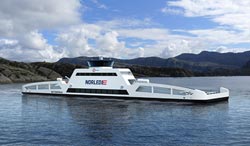First Car Ferry Powered by Electric Drive System

The 80-meter vessel can carry 120 cars and 360 passengers. From 2015 onward, it will serve the route between Lavik and Oppedal, across the Sognefjord. The ship's batteries will be recharged in the breaks between crossings, a procedure which only takes 10 minutes.
The vessel currently serving this route uses approx one million liters of diesel a year and emits 2680 metric tons of carbon dioxide and 37 metric tons of nitrogen oxides. The electrically powered ferry was developed for submission to a competition organized by Norway's Ministry of Transport. As a reward for winning the competition, the shipping company Norled has been granted the license to operate the route until 2025.
The ferry has been specially designed to accommodate the requirements of an electric drive system. As a catamaran with two slim hulls, it offers less resistance in the water than a conventional vessel. Furthermore, the hulls are made of aluminum instead of steel, which is conventionally used. Rather than a diesel engine, the ferry is equipped with electric motors to drive the ship's two screws. These motors are powered by a battery weighing 10 metric tons.
All in all, the new vessel weighs only half as much as a ferry of conventional design. This saving has a direct impact on the specifications of the drive system. Whereas the ferry currently serving the route has an engine with an output of 1,500 kilowatts (kW) or more than 2000 horsepower, the battery in the new vessel will have an output of 800 kW. In normal conditions, operating at a speed of 10 knots, battery power of 400 kW will suffice.
The crucial feature of the new ferry is that it only takes 10 minutes to recharge the batteries. In the two small villages linked by the ferry, however, the local grid is not equipped to deliver such a large amount of power in such a short space of time. To deal with this problem, batteries have been installed at each port.
These serve to recharge the ferry's battery during turnaround and are then themselves slowly recharged from the local grid.Hundreds of ferries link Norway's mainland to the islands off its coast and provide routes across its many fjords. Using today's battery and recharging technology, all crossings of up to 30 minutes in duration could be served by electrically powered vessels.
Media Contact
More Information:
http://www.siemens.com/innovationnewsAll latest news from the category: Power and Electrical Engineering
This topic covers issues related to energy generation, conversion, transportation and consumption and how the industry is addressing the challenge of energy efficiency in general.
innovations-report provides in-depth and informative reports and articles on subjects ranging from wind energy, fuel cell technology, solar energy, geothermal energy, petroleum, gas, nuclear engineering, alternative energy and energy efficiency to fusion, hydrogen and superconductor technologies.
Newest articles

Bringing bio-inspired robots to life
Nebraska researcher Eric Markvicka gets NSF CAREER Award to pursue manufacture of novel materials for soft robotics and stretchable electronics. Engineers are increasingly eager to develop robots that mimic the…

Bella moths use poison to attract mates
Scientists are closer to finding out how. Pyrrolizidine alkaloids are as bitter and toxic as they are hard to pronounce. They’re produced by several different types of plants and are…

AI tool creates ‘synthetic’ images of cells
…for enhanced microscopy analysis. Observing individual cells through microscopes can reveal a range of important cell biological phenomena that frequently play a role in human diseases, but the process of…





















